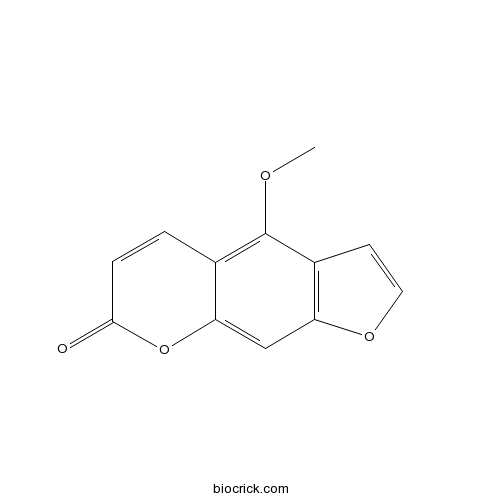Heracleum moellendorffii
Heracleum moellendorffii
1. The products in our compound library are selected from thousands of unique natural products; 2. It has the characteristics of diverse structure, diverse sources and wide coverage of activities; 3. Provide information on the activity of products from major journals, patents and research reports around the world, providing theoretical direction and research basis for further research and screening; 4. Free combination according to the type, source, target and disease of natural product; 5. The compound powder is placed in a covered tube and then discharged into a 10 x 10 cryostat; 6. Transport in ice pack or dry ice pack. Please store it at -20 °C as soon as possible after receiving the product, and use it as soon as possible after opening.
Natural products/compounds from Heracleum moellendorffii
- Cat.No. Product Name CAS Number COA
-
BCN5582
Bergapten484-20-8
Instructions

Anti-Melanogenic Activities of Heracleum moellendorffii via ERK1/2-Mediated MITF Downregulation.[Pubmed: 27827938]
None
Rapid Authentication of the Herbal Medicine Plant Species Aralia continentalis Kitag. and Angelica biserrata C.Q. Yuan and R.H. Shan Using ITS2 Sequences and Multiplex-SCAR Markers.[Pubmed: 26938512]
Accurate identification of the plant species that are present in herbal medicines is important for quality control. Although the dried roots of Aralia continentalis (Araliae Continentalis Radix) and Angelica biserrata (Angelicae Pubescentis Radix) are used in the same traditional medicine, namely Dok-Hwal in Korean and Du-Huo in Chinese, the medicines are described differently in the national pharmacopeia. Further confusion arises from the distribution of dried Levisticum officinale and Heracleum moellendorffii roots as the same medicine. Medicinal ingredients from all four plants are morphologically similar, and discrimination is difficult using conventional methods. Molecular identification methods offer rapidity and accuracy. The internal transcribed spacer 2 (ITS2) region of the nuclear ribosomal RNA gene (rDNA) was sequenced in all four plant species, and the sequences were used to design species-specific primers. Primers for each species were then combined to allow sample analysis in a single PCR reaction. Commercial herbal medicine samples were obtained from Korea and China and analyzed using the multiplex assay. The assay successfully identified authentic medicines and also identified inauthentic or adulterated samples. The multiplex assay will be a useful tool for identification of authentic Araliae Continentalis Radix and/or Angelicae Pubescentis Radix preparations in Korea and China.
Open channel block of hKv1.5 by psoralen from Heracleum moellendorffii Hance.[Pubmed: 15832811]
A furocoumarin derivative, psoralen (7H-furo[3,2-g][1]benzopyran-7-one), was isolated from the n-hexane fraction of Heracleum moellendorffii Hance. We examined the effects of psoralen on a human Kv1.5 potassium channel (hKv1.5) cloned from human heart and stably expressed in Ltk- cells. We found that psoralen inhibited the hKv1.5 current in a concentration-, use- and voltage-dependent manner with an IC50 value of 180 +/- 21 nM at +60 mV. Psoralen accelerated the inactivation kinetics of the hKv1.5 channel, and it slowed the deactivation kinetics of the hKv1.5 current resulting in a tail crossover phenomenon. These results indicate that psoralen acts on the hKv1.5 channel as an open channel blocker. Furthermore, psoralen prolonged the action potential duration of rat atrial muscles in a dose-dependent manner. Taken together, the present results strongly suggest that psoralen may be an ideal antiarrhythmic drug for atrial fibrillation.
Antiproliferative constituents in Umbelliferae plants II. Screening for polyacetylenes in some Umbelliferae plants, and isolation of panaxynol and falcarindiol from the root of Heracleum moellendorffii.[Pubmed: 9556156]
Methanol extracts of 36 samples of 21 Umbelliferae plants were screened for polyacetylenic compounds using the ELISA for panaxytriol, and their antiproliferative activity was checked by MTT assay using the tumor cell lines MK-1, HeLa and B16F10. The presence of antiproliferative polyacetylenes was suggested in Angelica acutiloba (fruit), Anethum graveolens (root), Bupleurum rotundifolium (fruit), Carum carvi (fruit and root), Coriandrum sativum (fruit), Cryptotaenia japonica (leaf), Glehnia littoralis (fruit), Heracleum moellendorffii (root) and Torilis japonica (fruit). Panaxynol and falcarindiol were successfully isolated from the root of Heracleum moellendorffii as antiproliferative polyacetylenes.


